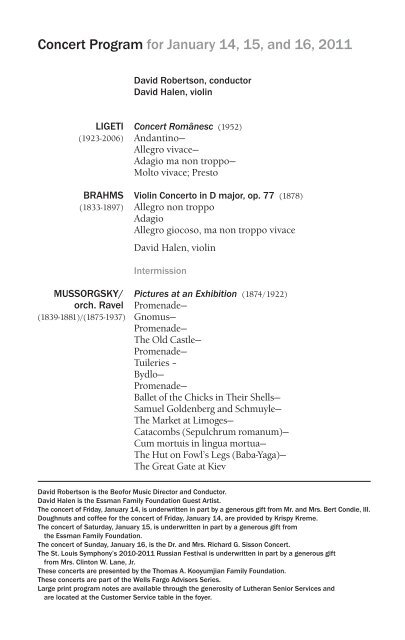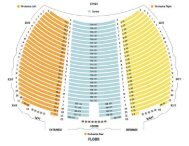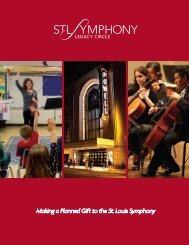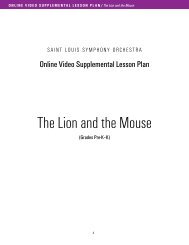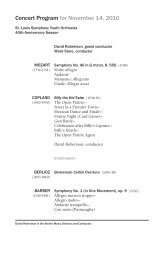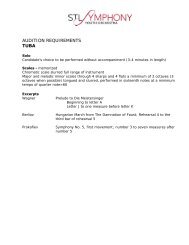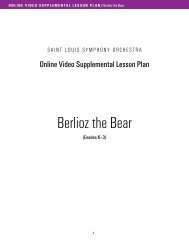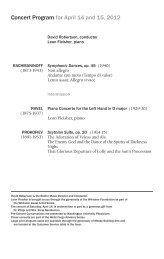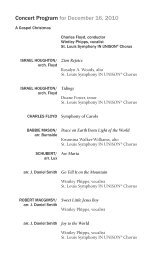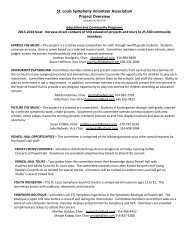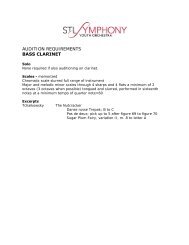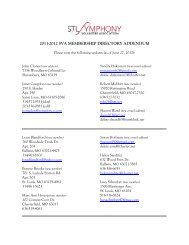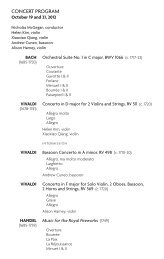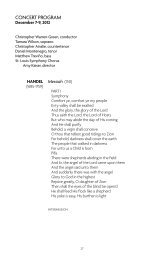Pictures at an Exhibition -- Jan. 14-16, 2011 - St. Louis Symphony
Pictures at an Exhibition -- Jan. 14-16, 2011 - St. Louis Symphony
Pictures at an Exhibition -- Jan. 14-16, 2011 - St. Louis Symphony
You also want an ePaper? Increase the reach of your titles
YUMPU automatically turns print PDFs into web optimized ePapers that Google loves.
Concert Program for J<strong>an</strong>uary <strong>14</strong>, 15, <strong>an</strong>d <strong>16</strong>, <strong>2011</strong><br />
David Robertson, conductor<br />
David Halen, violin<br />
LIGETI Concert Românesc (1952)<br />
(1923-2006) And<strong>an</strong>tino—<br />
Allegro vivace—<br />
Adagio ma non troppo—<br />
Molto vivace; Presto<br />
BRAHMS Violin Concerto in D major, op. 77 (1878)<br />
(1833-1897) Allegro non troppo<br />
Adagio<br />
Allegro giocoso, ma non troppo vivace<br />
David Halen, violin<br />
Intermission<br />
MUSSORGSKY/ <strong>Pictures</strong> <strong>at</strong> <strong>an</strong> <strong>Exhibition</strong> (1874/1922)<br />
orch. Ravel Promenade—<br />
(1839-1881)/(1875-1937) Gnomus—<br />
Promenade—<br />
The Old Castle—<br />
Promenade—<br />
Tuileries –<br />
Bydlo—<br />
Promenade—<br />
Ballet of the Chicks in Their Shells—<br />
Samuel Goldenberg <strong>an</strong>d Schmuyle—<br />
The Market <strong>at</strong> Limoges—<br />
C<strong>at</strong>acombs (Sepulchrum rom<strong>an</strong>um)—<br />
Cum mortuis in lingua mortua—<br />
The Hut on Fowl’s Legs (Baba-Yaga)—<br />
The Gre<strong>at</strong> G<strong>at</strong>e <strong>at</strong> Kiev<br />
David Robertson is the Beofor Music Director <strong>an</strong>d Conductor.<br />
David Halen is the Essm<strong>an</strong> Family Found<strong>at</strong>ion Guest Artist.<br />
The concert of Friday, J<strong>an</strong>uary <strong>14</strong>, is underwritten in part by a generous gift from Mr. <strong>an</strong>d Mrs. Bert Condie, III.<br />
Doughnuts <strong>an</strong>d coffee for the concert of Friday, J<strong>an</strong>uary <strong>14</strong>, are provided by Krispy Kreme.<br />
The concert of S<strong>at</strong>urday, J<strong>an</strong>uary 15, is underwritten in part by a generous gift from<br />
the Essm<strong>an</strong> Family Found<strong>at</strong>ion.<br />
The concert of Sunday, J<strong>an</strong>uary <strong>16</strong>, is the Dr. <strong>an</strong>d Mrs. Richard G. Sisson Concert.<br />
The <strong>St</strong>. <strong>Louis</strong> <strong>Symphony</strong>’s 2010-<strong>2011</strong> Russi<strong>an</strong> Festival is underwritten in part by a generous gift<br />
from Mrs. Clinton W. L<strong>an</strong>e, Jr.<br />
These concerts are presented by the Thomas A. Kooyumji<strong>an</strong> Family Found<strong>at</strong>ion.<br />
These concerts are part of the Wells Fargo Advisors Series.<br />
Large print program notes are available through the generosity of Luther<strong>an</strong> Senior Services <strong>an</strong>d<br />
are loc<strong>at</strong>ed <strong>at</strong> the Customer Service table in the foyer.
Michael Tammaro<br />
David Robertson Beofor Music Director <strong>an</strong>d Conductor<br />
A consumm<strong>at</strong>e musici<strong>an</strong>, masterful programmer, <strong>an</strong>d<br />
dynamic presence, David Robertson has established<br />
himself as one of today’s most sought-after Americ<strong>an</strong><br />
conductors. A passion<strong>at</strong>e <strong>an</strong>d compelling communic<strong>at</strong>or<br />
with <strong>an</strong> extensive knowledge of orchestral <strong>an</strong>d oper<strong>at</strong>ic<br />
repertoire, he has forged close rel<strong>at</strong>ionships with major<br />
orchestras around the world through his exhilar<strong>at</strong>ing<br />
music-making <strong>an</strong>d stimul<strong>at</strong>ing ideas. In fall 2010,<br />
Robertson beg<strong>an</strong> his sixth season as Music Director of the 131-year-old <strong>St</strong>.<br />
<strong>Louis</strong> <strong>Symphony</strong>, while continuing as Principal Guest Conductor of the<br />
BBC <strong>Symphony</strong> Orchestra, a post he has held since 2005.<br />
Highlights of Robertson’s 2010-11 season with the <strong>St</strong>. <strong>Louis</strong> <strong>Symphony</strong><br />
included a gala concert with sopr<strong>an</strong>o Renée Fleming, <strong>an</strong>d the orchestra’s<br />
forthcoming seventh consecutive appear<strong>an</strong>ce <strong>at</strong> New York’s Carnegie Hall.<br />
Guest engagements in the U.S. include perform<strong>an</strong>ces with the Boston,<br />
S<strong>an</strong> Fr<strong>an</strong>cisco, New World, <strong>an</strong>d S<strong>an</strong> Diego symphony orchestras, <strong>an</strong>d the<br />
New York Philharmonic. In March <strong>2011</strong> he conducts the Ensemble ACJW,<br />
the performing arm of the Academy, a professional training program<br />
for young musici<strong>an</strong>s developed by Carnegie Hall, the Juilliard School,<br />
<strong>an</strong>d the Weill Institute, in a program combining Mozart’s unfinished<br />
opera Zaide (Das Serail) <strong>an</strong>d the New York premiere of Luci<strong>an</strong>o Berio’s<br />
reconstruction of the same piece. Intern<strong>at</strong>ionally, guest engagements<br />
include the Royal Concertgebouw Orchestra, where Robertson appears<br />
regularly, the Deutsches Symphonie-Orchester Berlin as part of Musikfest<br />
Berlin, <strong>an</strong>d several concerts with the BBC <strong>Symphony</strong>. In addition to his<br />
fresh interpret<strong>at</strong>ions of traditional repertoire, this season Robertson<br />
conducts world premieres of works by <strong>St</strong>ephen McNeff, Avner Dorm<strong>an</strong>,<br />
Joey Roukens, <strong>an</strong>d Christopher Rouse.<br />
Born in S<strong>an</strong>ta Monica, California, Robertson was educ<strong>at</strong>ed <strong>at</strong><br />
London’s Royal Academy of Music, where he studied French horn <strong>an</strong>d<br />
composition before turning to orchestral conducting. Robertson received<br />
Columbia University’s 2006 Ditson Conductor’s Award, <strong>an</strong>d he <strong>an</strong>d the <strong>St</strong>.<br />
<strong>Louis</strong> <strong>Symphony</strong> are recipients of three major awards from ASCAP <strong>an</strong>d the<br />
League of Americ<strong>an</strong> Orchestras, including the 2009-10 <strong>an</strong>d 2008-09 Award<br />
for Programming of Contemporary Music, <strong>an</strong>d the 2005-06 Morton Gould<br />
Award for Innov<strong>at</strong>ive Programming. Musical America named Robertson<br />
Conductor of the Year for 2000. In 1997, he received the Seaver/N<strong>at</strong>ional<br />
Endowment for the Arts Conductors Award, the premier prize of its kind,<br />
given to exceptionally gifted Americ<strong>an</strong> conductors. He is the recipient of<br />
honorary doctor<strong>at</strong>es from Westminster Choir College, Webster University,<br />
<strong>an</strong>d Maryville University, as well as the 2010 Excellence in the Arts award<br />
from the <strong>St</strong>. <strong>Louis</strong> Arts <strong>an</strong>d Educ<strong>at</strong>ion Council. In 2010 he was elected a<br />
Fellow of the Americ<strong>an</strong> Academy of Arts <strong>an</strong>d Sciences. David Robertson<br />
<strong>an</strong>d his wife, pi<strong>an</strong>ist Orli Shaham, are parents of twin boys. Robertson also<br />
has two older sons.
David Halen Essm<strong>an</strong> Family Found<strong>at</strong>ion Guest Artist<br />
David Halen is living a dream th<strong>at</strong> beg<strong>an</strong> as a youth<br />
the first time he saw the <strong>St</strong>. <strong>Louis</strong> <strong>Symphony</strong> perform<br />
in Warrensburg, Missouri. Born in Bellevue, Ohio,<br />
he didn’t have to look far for his musical influences:<br />
his f<strong>at</strong>her, the l<strong>at</strong>e Walter J. Halen, was also his violin<br />
professor <strong>at</strong> Central Missouri <strong>St</strong><strong>at</strong>e University; his<br />
mother, a former member of the K<strong>an</strong>sas City <strong>Symphony</strong>;<br />
<strong>an</strong>d his older brother, the Acting Concertmaster of the<br />
Houston <strong>Symphony</strong> Orchestra. Halen beg<strong>an</strong> playing the violin <strong>at</strong> the age<br />
of six, <strong>an</strong>d earned his bachelor’s degree <strong>at</strong> the age of 19. In th<strong>at</strong> same year,<br />
he won the Music Teachers N<strong>at</strong>ional Associ<strong>at</strong>ion Competition <strong>an</strong>d was<br />
gr<strong>an</strong>ted a Fulbright scholarship for study with Wolfg<strong>an</strong>g Marschner <strong>at</strong> the<br />
Freiburg Hochschule für Musik in Germ<strong>an</strong>y, the youngest recipient ever to<br />
have been honored with this prestigious award. In addition, Halen holds<br />
a master’s degree from the University of Illinois <strong>at</strong> Champaign-Urb<strong>an</strong>a,<br />
studying with Sergiu Luca.<br />
Halen served as Assist<strong>an</strong>t Concertmaster with the Houston<br />
<strong>Symphony</strong> Orchestra under Sergiu Comissiona <strong>an</strong>d Christoph Eschenbach<br />
until 1991. He then came to <strong>St</strong>. <strong>Louis</strong>, where he was perm<strong>an</strong>ently named<br />
Concertmaster in September 1995, without audition, by the orchestra,<br />
<strong>an</strong>d with the endorsement of then Music Directors Leonard Sl<strong>at</strong>kin <strong>an</strong>d<br />
H<strong>an</strong>s Vonk.<br />
During the summer he teaches <strong>an</strong>d performs extensively, serving<br />
as Concertmaster <strong>at</strong> the Aspen Music Festival <strong>an</strong>d School. He has also<br />
soloed, taught, <strong>an</strong>d served as Concertmaster extensively <strong>at</strong> the Orford Arts<br />
Centre in Quebec, the M<strong>an</strong>h<strong>at</strong>t<strong>an</strong> School of Music, Indi<strong>an</strong>a University, the<br />
N<strong>at</strong>ional Orchestra Institute <strong>at</strong> the University of Maryl<strong>an</strong>d, the Academy of<br />
the West in S<strong>an</strong>ta Barbara, <strong>an</strong>d the New World <strong>Symphony</strong> in Miami Beach.<br />
In 2007 he was appointed Distinguished Visiting Artist <strong>at</strong> Yale University,<br />
<strong>an</strong>d <strong>at</strong> the new Robert McDuffie Center for <strong>St</strong>rings <strong>at</strong> Mercer University in<br />
Macon, Georgia.<br />
As co-founder <strong>an</strong>d artistic director of the Innsbrook Institute, Halen<br />
coordin<strong>at</strong>es a weeklong festival, in June, of exciting musical perform<strong>an</strong>ces<br />
<strong>an</strong>d <strong>an</strong> enclave for aspiring artists. In August, he is artistic director of the<br />
Missouri River Festival of the Arts in Boonville, Missouri. His numerous<br />
accolades include the 2002 <strong>St</strong>. <strong>Louis</strong> Arts <strong>an</strong>d Entertainment Award<br />
for Excellence, <strong>an</strong>d <strong>an</strong> honorary doctor<strong>at</strong>e from Central Missouri <strong>St</strong><strong>at</strong>e<br />
University <strong>an</strong>d from the University of Missouri-<strong>St</strong>. <strong>Louis</strong>.<br />
Halen plays on a 1753 Giov<strong>an</strong>ni B<strong>at</strong>tista Guadagnini violin, made in<br />
Mil<strong>an</strong>, Italy. He is married to Kore<strong>an</strong>-born sopr<strong>an</strong>o Mir<strong>an</strong> Cha Halen <strong>an</strong>d<br />
has a 13-year-old son.<br />
David Halen most recently performed as a soloist with the <strong>St</strong>. <strong>Louis</strong><br />
<strong>Symphony</strong> in December 2009.<br />
Suzy Gorm<strong>an</strong>
Musical Images<br />
BY PAUL SCHIAVO<br />
Ideas <strong>at</strong> Play<br />
One of the oldest <strong>an</strong>d most intriguing questions about music is whether,<br />
<strong>an</strong>d to wh<strong>at</strong> extent, melody, harmony, <strong>an</strong>d instrumental color c<strong>an</strong> convey<br />
impressions of <strong>an</strong>ything beyond… well, beyond just the phenomena of<br />
melody, harmony, <strong>an</strong>d instrumental color. C<strong>an</strong> music denote events or<br />
things in the physical world? C<strong>an</strong> it conjure up images in our minds? Or is<br />
it a self-contained art form, <strong>an</strong> intric<strong>at</strong>e <strong>an</strong>d delightful play of sounds but<br />
having no implic<strong>at</strong>ions beyond merely th<strong>at</strong>?<br />
The three compositions th<strong>at</strong> make up our program imply different<br />
<strong>an</strong>swers to these questions. On the one h<strong>an</strong>d, Joh<strong>an</strong>nes Brahms’ magisterial<br />
Violin Concerto makes the case for music as <strong>an</strong> essentially abstract art. Its<br />
music conveys different emotional st<strong>at</strong>es, perhaps, <strong>an</strong>d maybe a subliminal<br />
sense of drama. But the specific n<strong>at</strong>ure of th<strong>at</strong> drama, like the source of<br />
wh<strong>at</strong>ever emotions we perceive in the music, are unknowable. On the<br />
other h<strong>an</strong>d, Modest Mussorgsky’s <strong>Pictures</strong> <strong>at</strong> <strong>an</strong> <strong>Exhibition</strong> purports a<br />
correspondence between its various movements <strong>an</strong>d images cre<strong>at</strong>ed by a<br />
Russi<strong>an</strong> painter <strong>an</strong>d draftsm<strong>an</strong>, a correspondence th<strong>at</strong> implies a certain<br />
connection between musical <strong>an</strong>d visual sens<strong>at</strong>ion.<br />
Somewh<strong>at</strong> between these two extremes is the first work we hear,<br />
György Ligeti’s Concert Românesc. Its music implies village singing <strong>an</strong>d<br />
d<strong>an</strong>cing, as well as the dist<strong>an</strong>t calls of mountain horns. Do these constitute<br />
musical pictures, or a more indefinite kind of associ<strong>at</strong>ion? The finale of<br />
Brahms’ concerto also entails a folkloric element, the sound of gypsy<br />
fiddling. Perhaps th<strong>at</strong> composition is not so abstract after all.<br />
György Ligeti Concert Românesc<br />
Born: Tirnaveni, Tr<strong>an</strong>sylv<strong>an</strong>ia, May 28, 1923 Died: Vienna, June 12, 2006 First<br />
perform<strong>an</strong>ce: August 21, 1971, in Fish Creek, Wisconsin; Thor Johnson conducted<br />
the Peninsula Music Festival Orchestra STL <strong>Symphony</strong> premiere: February 24,<br />
2006, with Roberto Minczuk conducting the only previous perform<strong>an</strong>ce Scoring:<br />
Two flutes <strong>an</strong>d piccolo, two oboes <strong>an</strong>d English horn, two clarinets <strong>an</strong>d two<br />
bassoons, three horns, two trumpets, percussion, <strong>an</strong>d strings Perform<strong>an</strong>ce time:<br />
Approxim<strong>at</strong>ely 12 minutes<br />
Ligeti<br />
In Context 1952 Paul Robeson awarded <strong>St</strong>alin Peace Prize<br />
from the Soviet Union; director Elia Kaz<strong>an</strong> identifies actors<br />
as members of communist cell before House Un-Americ<strong>an</strong><br />
Activities Committee; future Russi<strong>an</strong> prime minister <strong>an</strong>d<br />
president Vladimir Putin born in Leningrad<br />
György Ligeti, one of the most original <strong>an</strong>d import<strong>an</strong>t<br />
musical thinkers of the last half century, was born in<br />
Tr<strong>an</strong>sylv<strong>an</strong>ia, th<strong>at</strong> fabled <strong>an</strong>d much disputed province<br />
lying on the border of Hungary <strong>an</strong>d Rom<strong>an</strong>ia. Surviving<br />
both Nazi occup<strong>at</strong>ion <strong>an</strong>d the first decade of communist
Ligeti<br />
rule in Hungary, Ligeti escaped to the West, where he came to prominence<br />
with a series of remarkable compositions written during the 1960s. In<br />
those works, the usual details of melody, harmony, <strong>an</strong>d rhythm collapsed<br />
into tightly woven webs of sound. Individual notes were absorbed into<br />
dense chords yielding cloudlike sonorities of seemingly indefinite pitch;<br />
melodic lines piled up to form t<strong>an</strong>gled knots of counterpoint, or else were<br />
pulled taut in long str<strong>an</strong>ds of sustained sonority. The result was a str<strong>an</strong>ge<br />
new musical world, <strong>at</strong> once visceral <strong>an</strong>d dreamlike, th<strong>at</strong> became familiar<br />
to a wide audience when several of Ligeti’s compositions were used in the<br />
soundtrack of <strong>St</strong><strong>an</strong>ley Kubrick’s popular film 2001: A Space Odyssey.<br />
During the 1970s <strong>an</strong>d beyond, Ligeti’s music continued to evolve in<br />
fascin<strong>at</strong>ing <strong>an</strong>d unpredictable directions. A number of his l<strong>at</strong>e works—<br />
most notably his Pi<strong>an</strong>o Concerto, Violin Concerto, <strong>an</strong>d Etudes for pi<strong>an</strong>o—<br />
have been taken up by a growing number of performers <strong>an</strong>d have found<br />
a wide audience gr<strong>at</strong>eful for music th<strong>at</strong> is both extraordinarily innov<strong>at</strong>ive<br />
<strong>an</strong>d rewarding <strong>at</strong> the highest artistic level.<br />
Concert Românesc, however, is <strong>an</strong> early work, written in 1952, while<br />
Ligeti was still living in Communist Hungary. (The composer fled his<br />
homel<strong>an</strong>d for the West during the uprising of 1956.) Throughout the<br />
<strong>St</strong>alinist Soviet bloc, concert music in a folkloric vein was encouraged by<br />
government officials. Ligeti, who had already had <strong>an</strong> uncomfortable brush<br />
with Party overseers, ostensibly heeded th<strong>at</strong> pressure in writing Concert<br />
Românesc. He was, in fact, genuinely interested in Rom<strong>an</strong>i<strong>an</strong> folk music,<br />
which he had often heard during his youth <strong>an</strong>d had studied <strong>at</strong> the Folklore<br />
Institute of Bucharest, in 1949.<br />
Some of the melodies Ligeti had learned during his research made<br />
their way into his “Rom<strong>an</strong>i<strong>an</strong> Concerto.” But, as the composer observed of<br />
this piece, “not everything in it is genuinely Rom<strong>an</strong>i<strong>an</strong>, as I also invented<br />
elements in the spirit of the village b<strong>an</strong>ds.” The original touches, <strong>an</strong>d<br />
especially some daring harmonies in the final movement, led to the work<br />
being b<strong>an</strong>ned after a single rehearsal in Budapest. It did not receive a<br />
public perform<strong>an</strong>ce until 1971.<br />
The Music: The four short movements of Concert Românesc follow one<br />
<strong>an</strong>other without pause. The first evokes peas<strong>an</strong>t singing, while the second<br />
brings a lively folk d<strong>an</strong>ce scored in a particularly vibr<strong>an</strong>t m<strong>an</strong>ner. The third<br />
movement grew out of the composer’s memory of hearing the sound of the<br />
bucium, a Rom<strong>an</strong>i<strong>an</strong> mountain horn, during a boyhood excursion in the<br />
Carp<strong>at</strong>hi<strong>an</strong> mountains. Here, the composer writes <strong>an</strong> echoing duet for two<br />
horns, calling to each other from a dist<strong>an</strong>ce, <strong>an</strong>d instructs the players to use<br />
“n<strong>at</strong>ural” tuning, which produces a peculiar melodic inflection.<br />
The final movement again conveys the energy <strong>an</strong>d spirit of a folk<br />
d<strong>an</strong>ce, but in a more wild <strong>an</strong>d unrestrained fashion th<strong>an</strong> we heard in the<br />
second movement. Ligeti believed th<strong>at</strong> it was chiefly this portion of the<br />
piece th<strong>at</strong> caused it to be suppressed in Communist Hungary. And it is<br />
this movement—particularly its abrupt contrasts of texture <strong>an</strong>d volume, its<br />
striking <strong>an</strong>d unusual instrumental colors, <strong>an</strong>d its rhythmic complexity—<br />
th<strong>at</strong> hints, however faintly, <strong>at</strong> the remarkable new developments th<strong>at</strong><br />
Ligeti’s music would propose after his escape to the West.
Brahms<br />
Joh<strong>an</strong>nes Brahms Violin Concerto in D major, op. 77<br />
Born: Hamburg, May 7, 1833 Died: Vienna, April 3, 1897 First perform<strong>an</strong>ce:<br />
J<strong>an</strong>uary 1, 1879, in Leipzig. Joseph Joachim was the soloist, <strong>an</strong>d the composer<br />
conducted the Leipzig Gew<strong>an</strong>dhaus Orchestra STL <strong>Symphony</strong> premiere: J<strong>an</strong>uary<br />
17, 1913, Efrem Zimbalist was soloist, with Max Zach conducting Most recent<br />
STL <strong>Symphony</strong> perform<strong>an</strong>ce: April 25, 2004, Vadim Repin was soloist, with David<br />
Robertson conducting Scoring: Solo violin <strong>an</strong>d <strong>an</strong> orchestra of two flutes, two<br />
oboes, two clarinets, two bassoons, four horns, two trumpets, timp<strong>an</strong>i, <strong>an</strong>d strings<br />
Perform<strong>an</strong>ce time: Approxim<strong>at</strong>ely 38 minutes<br />
In Context 1878 Eadweard Muybridge cre<strong>at</strong>es “motion”<br />
pictures by utilizing multiple cameras to photograph a<br />
galloping horse; Joseph Pulitzer buys the <strong>St</strong>. <strong>Louis</strong> Post-<br />
Disp<strong>at</strong>ch; Tchaikovsky’s <strong>Symphony</strong> No. 4 premieres<br />
Joh<strong>an</strong>nes Brahms was <strong>an</strong> obscure young pi<strong>an</strong>ist <strong>an</strong>d<br />
fledgling composer when he first met Joseph Joachim in<br />
1853. Already a famous violinist, <strong>an</strong>d soon to become<br />
one of the foremost instrumentalists of the 19th century,<br />
Brahms Joachim nevertheless recognized the enormity of his<br />
colleague’s gift. “I have never come across a talent like his<br />
before,” Joachim wrote <strong>at</strong> the time. “He is miles ahead of me.” Before long,<br />
the two men had established a firm friendship; though not always smooth,<br />
it endured some four-<strong>an</strong>d-a-half decades, until Brahms’ de<strong>at</strong>h, in 1897.<br />
The Brahms-Joachim rel<strong>at</strong>ionship produced a number of t<strong>an</strong>gible<br />
results, the gre<strong>at</strong>est coming in 1878. In August of th<strong>at</strong> year, the composer,<br />
who habitually slighted his cre<strong>at</strong>ive efforts, sent Joachim “a few violin<br />
passages” to try out. These “passages” proved to be the first movement<br />
<strong>an</strong>d part of the finale to a concerto he had sketched during the summer.<br />
Joachim responded enthusiastically to these pages <strong>an</strong>d encouraged<br />
Brahms to proceed with the work.<br />
During the following months the two musici<strong>an</strong>s corresponded<br />
frequently <strong>an</strong>d met several times to try out portions of the concerto as it<br />
took shape. Brahms originally pl<strong>an</strong>ned the work to be in four movements<br />
(he would realize this unorthodox concerto form<strong>at</strong> three years l<strong>at</strong>er<br />
in his Pi<strong>an</strong>o Concerto No. 2), but eventually discarded the two central<br />
movements in favor of wh<strong>at</strong> he belittled as a “poor Adagio.” By pressing<br />
Brahms to work faster th<strong>an</strong> was his habit, Joachim was able to perform<br />
the Violin Concerto for the first time on New Year’s Day, 1879, in Leipzig.<br />
The Music: Knowing the esteem in which Brahms held Joachim, it is<br />
not difficult to imagine this composition as a kind of portrait of, or<br />
homage to, the violinist. The first movement is marked by the blend of<br />
unpretentious gr<strong>an</strong>deur <strong>an</strong>d controlled energy established in the long<br />
orchestral exposition. Characteristically, Brahms forges each of the<br />
themes presented in this passage from several brief interlocking melodies<br />
th<strong>at</strong> c<strong>an</strong> exp<strong>an</strong>d, develop, <strong>an</strong>d play off each other. The violin proceeds to<br />
amplify this them<strong>at</strong>ic m<strong>at</strong>erial presented by the orchestra <strong>an</strong>d contributes<br />
<strong>an</strong> exceptionally lovely melody of its own.
Brahms<br />
The “poor Adagio” is clearly <strong>an</strong> expression of gre<strong>at</strong> tenderness <strong>an</strong>d<br />
affection. Brahms opens with one of his most beautiful <strong>an</strong>d long‐bre<strong>at</strong>hed<br />
melodies. (It is also one of the gre<strong>at</strong> oboe solos in the orchestral liter<strong>at</strong>ure.)<br />
Although the music passes across more troubled thoughts in the central<br />
portion of the movement, it returns to its initial melodic impulse <strong>an</strong>d the<br />
peaceful vein in which it beg<strong>an</strong>.<br />
The Hungari<strong>an</strong> flavor of the finale is certainly a bow to Joachim,<br />
who not only was of Hungari<strong>an</strong> background but had himself written<br />
a “Hungari<strong>an</strong> Concerto” <strong>an</strong>d dedic<strong>at</strong>ed it to Brahms. It is above all the<br />
recurring principal theme of this rondo‐form movement th<strong>at</strong> evokes<br />
the gypsy violin style th<strong>at</strong> Joachim knew <strong>an</strong>d Brahms loved so well. The<br />
intervening episodes contribute energy <strong>an</strong>d bravura passagework.<br />
Modest Mussorgsky/Orchestr<strong>at</strong>ed by Maurice Ravel<br />
<strong>Pictures</strong> <strong>at</strong> <strong>an</strong> <strong>Exhibition</strong><br />
Born: Karevo, Russia, March 21, 1839 Died: <strong>St</strong>. Petersburg on March 28, 1881<br />
Maurice Ravel Born: Ciboure, southwest Fr<strong>an</strong>ce, March 7, 1875 Died: Paris,<br />
December 28, 1937 First perform<strong>an</strong>ce: October 19, 1922, in Paris, conducted<br />
by Serge Koussevitzky STL <strong>Symphony</strong> premiere: October 31, 1930, Enrique<br />
Fernández Arbós conducting Most recent STL <strong>Symphony</strong> perform<strong>an</strong>ce: October<br />
26, 2008, Ingo Metzmacher conducting Scoring: Three flutes <strong>an</strong>d two piccolos,<br />
three oboes <strong>an</strong>d English horn, two clarinets <strong>an</strong>d bass clarinet, alto saxophone,<br />
two bassoons <strong>an</strong>d contrabassoon, four horns, three trumpets, three trombones,<br />
tuba, timp<strong>an</strong>i <strong>an</strong>d percussion, two harps, celesta, <strong>an</strong>d strings Perform<strong>an</strong>ce time:<br />
Approxim<strong>at</strong>ely 35 minutes<br />
In Context 1874 Tolstoy writes Anna Karenina; Joh<strong>an</strong>n<br />
<strong>St</strong>rauss, Jr.’s opera Die Fledermaus produced in Vienna 1922<br />
James Joyce’s Ulysses published in Paris; Marcel Proust dies<br />
In 1874, Modest Mussorgsky was immersed in the<br />
composition of his huge opera Khov<strong>an</strong>shchina when he<br />
received word of a memorial exhibit of pictures by the<br />
artist <strong>an</strong>d architect Victor Hartm<strong>an</strong>n, who had died a year<br />
earlier. Hartm<strong>an</strong>n had been a close friend of the composer,<br />
Mussorgsky <strong>an</strong>d after visiting the gallery where his l<strong>at</strong>e comp<strong>an</strong>ion’s<br />
pictures were displayed, Mussorgsky resolved to pay his<br />
own tribute by writing a set of pi<strong>an</strong>o pieces inspired by the drawings.<br />
In June he wrote to the art critic Vladimir <strong>St</strong>asov, the org<strong>an</strong>izer of the<br />
exhibition: “My ‘Hartm<strong>an</strong>n’ is boiling…. Sounds <strong>an</strong>d ideas fill the air, <strong>an</strong>d<br />
I c<strong>an</strong> barely scribble them down fast enough.” This report c<strong>an</strong> scarcely<br />
be doubted. Mussorgsky worked with remarkable speed, completing the<br />
lengthy score on June 22.<br />
The finished work represented 10 of Hartm<strong>an</strong>n’s images, a form<strong>at</strong><br />
th<strong>at</strong> might have made for a loose suite of unrel<strong>at</strong>ed movements. But<br />
Mussorgsky prefaced his musical pictures with a prelude in which he<br />
imagined himself, as he described, “roving through the exhibition—now<br />
leisurely, now briskly—in order to come close to a picture th<strong>at</strong> has <strong>at</strong>tracted
Mussorgsky/Ravel<br />
[my] <strong>at</strong>tention.” The theme of this “Promenade” served<br />
to unify the composition: it forms the subject of several<br />
interludes between movements <strong>an</strong>d reappears in two of<br />
them—mysteriously in “C<strong>at</strong>acombs” <strong>an</strong>d triumph<strong>an</strong>tly in<br />
“The Gre<strong>at</strong> G<strong>at</strong>e <strong>at</strong> Kiev.”<br />
<strong>Pictures</strong> <strong>at</strong> <strong>an</strong> <strong>Exhibition</strong>, like so much of Mussorgsky’s<br />
music, was performed infrequently during the composer’s<br />
lifetime. Mussorgsky’s then radically adv<strong>an</strong>ced harmonies<br />
Ravel<br />
<strong>an</strong>d str<strong>an</strong>ge melodic twists were scarcely appreci<strong>at</strong>ed in<br />
his n<strong>at</strong>ive Russia, <strong>an</strong>d even less so in the West. (Indeed,<br />
a good deal of effort was expended in “correcting” his scores in the years<br />
after his de<strong>at</strong>h.) But the situ<strong>at</strong>ion beg<strong>an</strong> to ch<strong>an</strong>ge during the first decades<br />
of the 20th century, as Mussorgsky found admirers among the early<br />
modernists. In 1922, conductor Serge Koussevitsky commissioned the<br />
French composer Maurice Ravel to orchestr<strong>at</strong>e <strong>Pictures</strong> <strong>at</strong> <strong>an</strong> <strong>Exhibition</strong>.<br />
Ravel’s orchestr<strong>at</strong>ion is every bit as original as Mussorgsky’s composition,<br />
<strong>an</strong>d it perfectly captures the character of each movement.<br />
The Music: The music is sufficiently suggestive th<strong>at</strong> the individual<br />
“pictures” require but a little description. “Tuileries” is the famous gardens<br />
in Paris, here portrayed with children <strong>at</strong> play. “Ballet of the Chicks in<br />
Their Shells” derives from Hartm<strong>an</strong>n’s sketch of decor for a diversion by<br />
Marius Petipa, the renowned choreographer <strong>at</strong> the Imperial The<strong>at</strong>er in<br />
<strong>St</strong>. Petersburg. “Samuel Goldenberg <strong>an</strong>d Schmuyle” is a composite of two<br />
figures Hartm<strong>an</strong>n drew near the Warsaw ghetto. Mussorgsky, who owned<br />
these drawings, described them as “two Jews, one rich, the other poor,”<br />
<strong>an</strong>d they seem to be quarreling.<br />
“C<strong>at</strong>acombs” is for a drawing Hartm<strong>an</strong>n made of the famous Rom<strong>an</strong><br />
tombs. Its music continues directly into Mussorgsky’s medit<strong>at</strong>ion on <strong>an</strong><br />
inscription there: “Cum mortuis in lingua mortua”—“With the Dead in a<br />
Dead L<strong>an</strong>guage.” “Baba-Yaga” depicts a witch familiar in Russi<strong>an</strong> folklore.<br />
She lives in a dreadful hut adorned with hum<strong>an</strong> skulls <strong>an</strong>d th<strong>at</strong> walks<br />
through the forest on gi<strong>an</strong>t chicken legs.<br />
In these <strong>an</strong>d other movements, Ravel’s orchestr<strong>at</strong>ion adds to the<br />
character of each “picture.” This is just as true, perhaps even more so,<br />
when he resorts to unorthodox choices of instruments. The saxophone’s<br />
present<strong>at</strong>ion of the mournful melody of “The Old Castle,” for example, is<br />
as effective as it is unexpected. The folk tune heard in “Bydlo” (whose title<br />
refers to a three‐wheeled c<strong>at</strong>tle cart) is both ponderous <strong>an</strong>d lyrical when<br />
sung in the high register of the tuba.<br />
The finale depicts Hartm<strong>an</strong>n’s design for a majestic stone arch to be<br />
built over a small chapel in the <strong>an</strong>cient city of Kiev. Mussorgsky imagines<br />
both the church—we hear a traditional Russi<strong>an</strong> hymn <strong>an</strong>d ringing bells—<br />
<strong>an</strong>d the gre<strong>at</strong> arch sheltering it.<br />
Program notes © <strong>2011</strong> by Paul Schiavo


